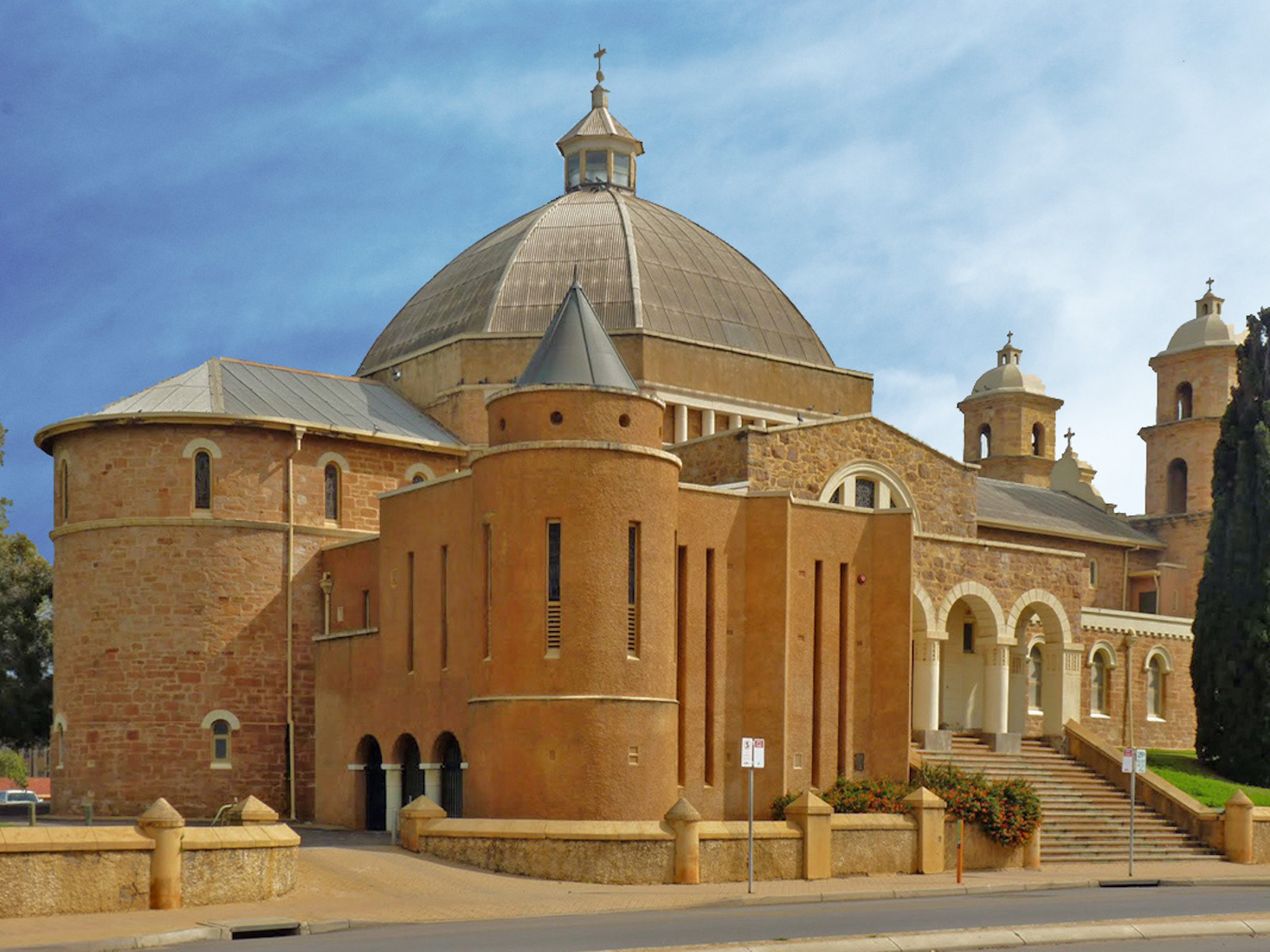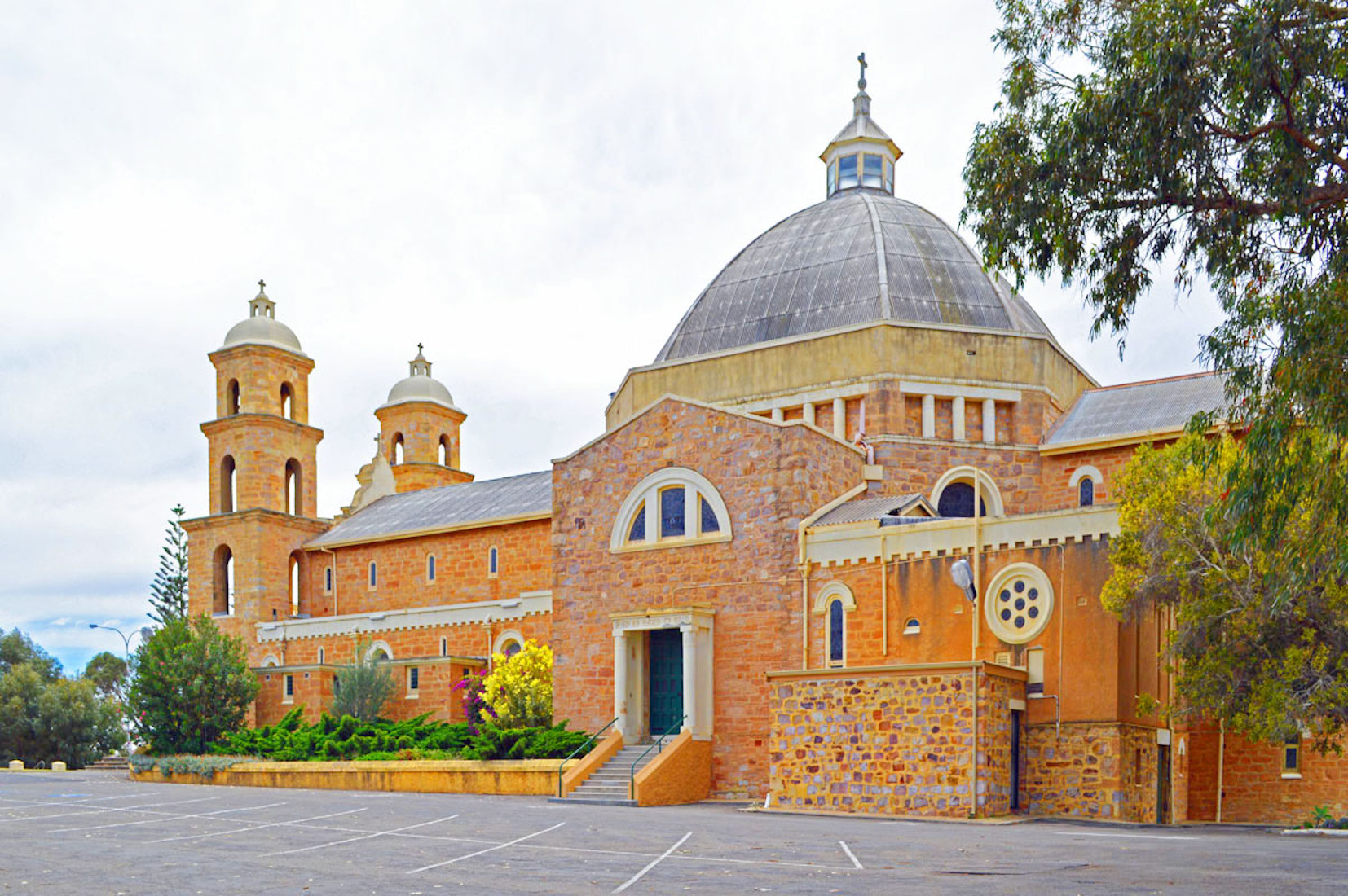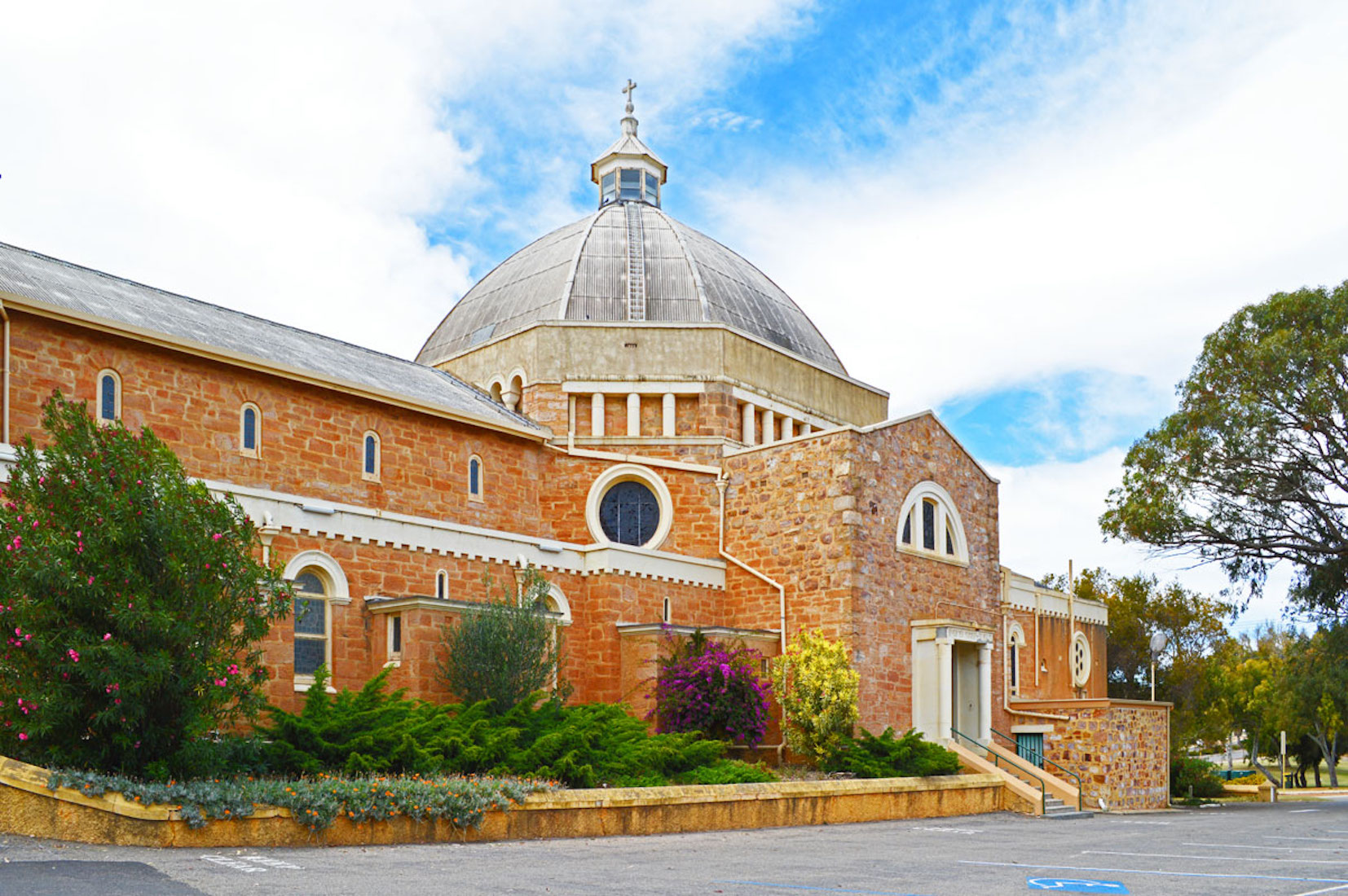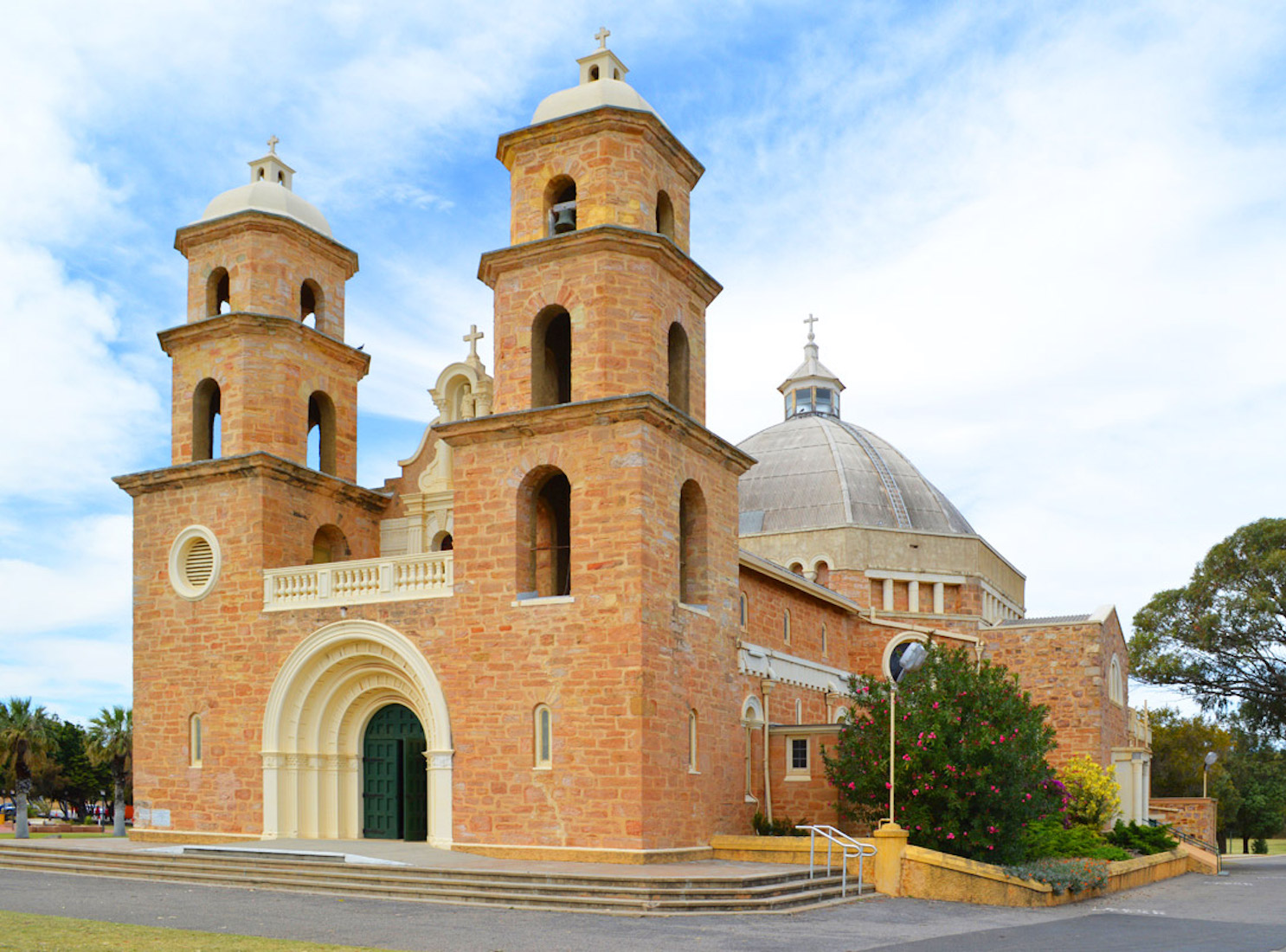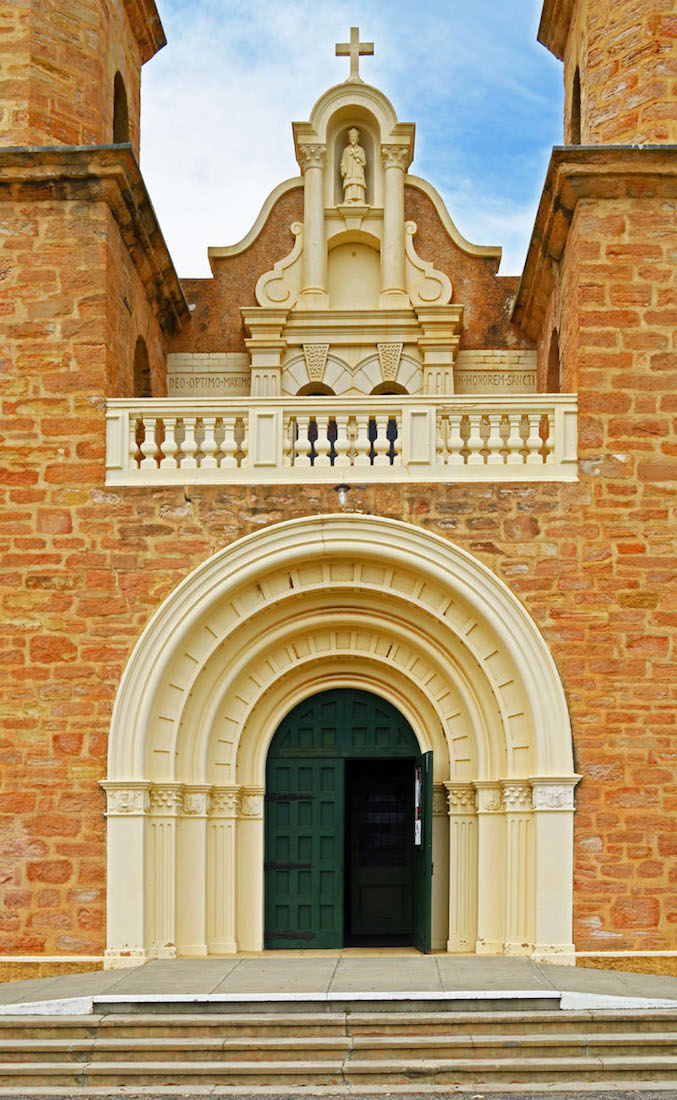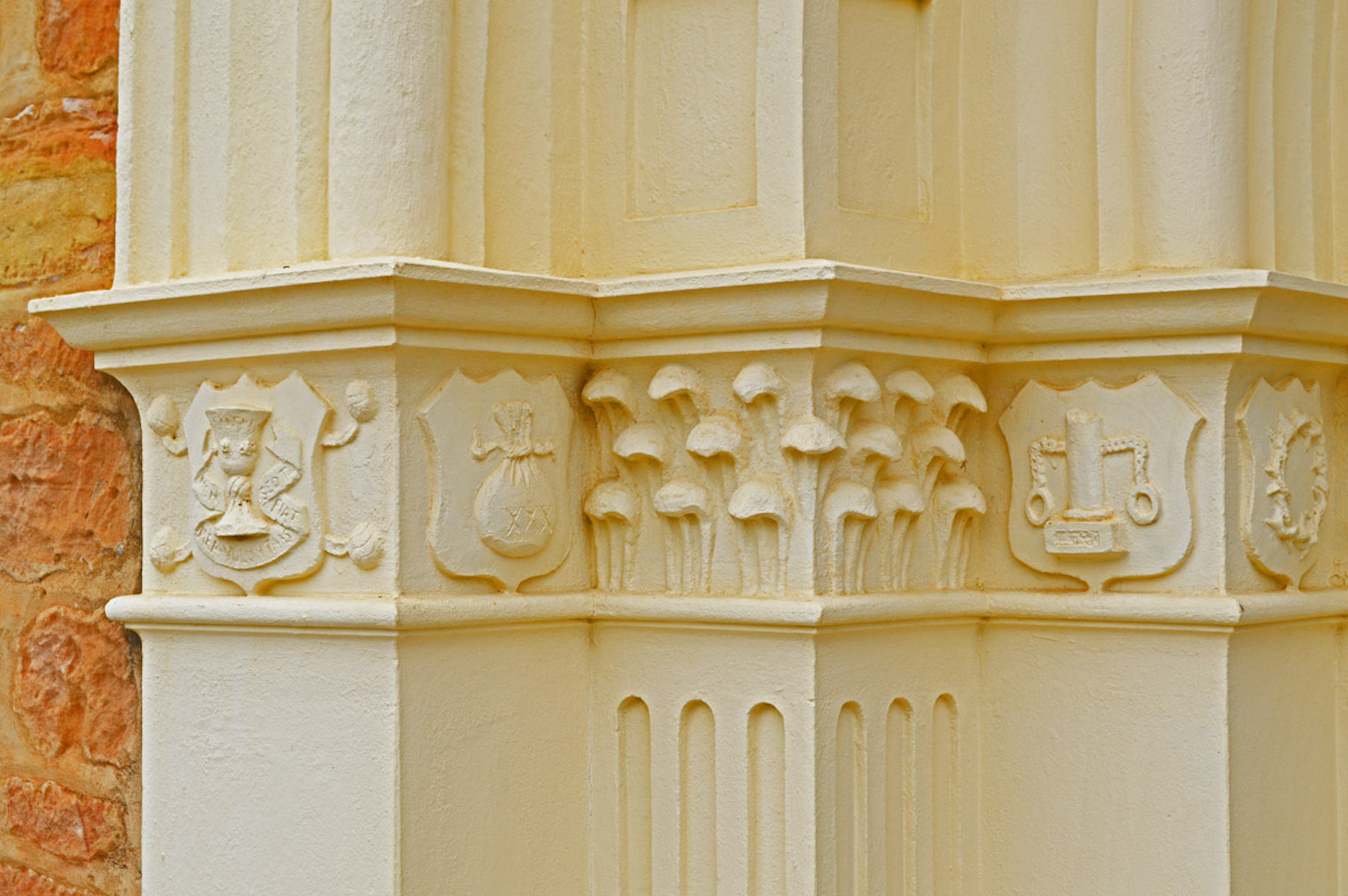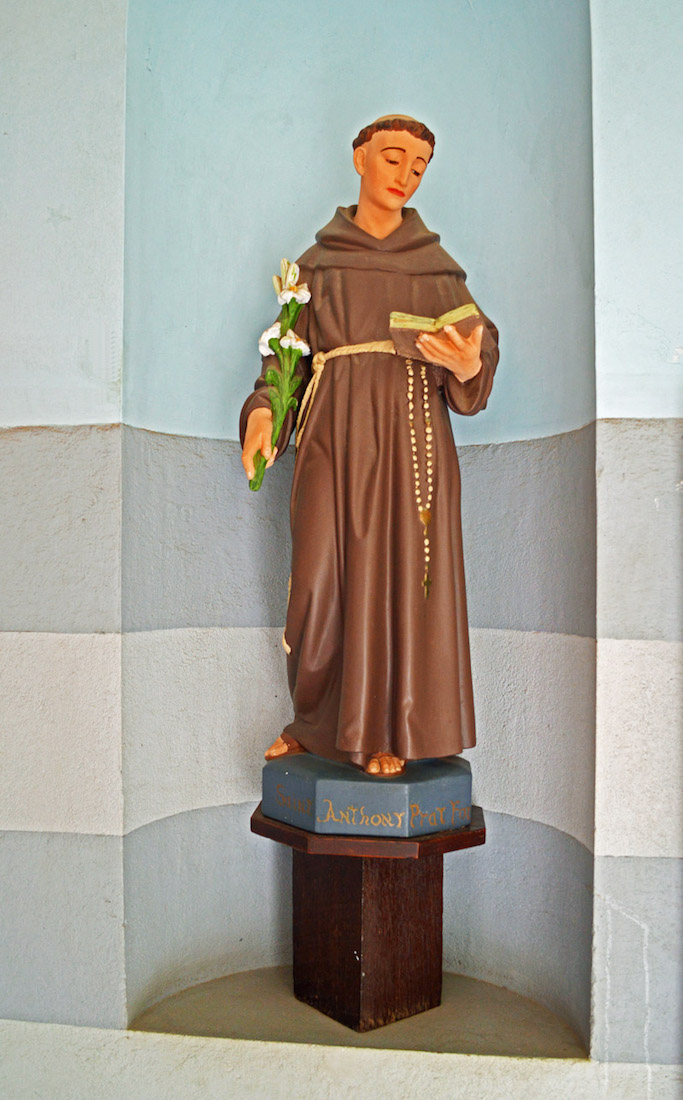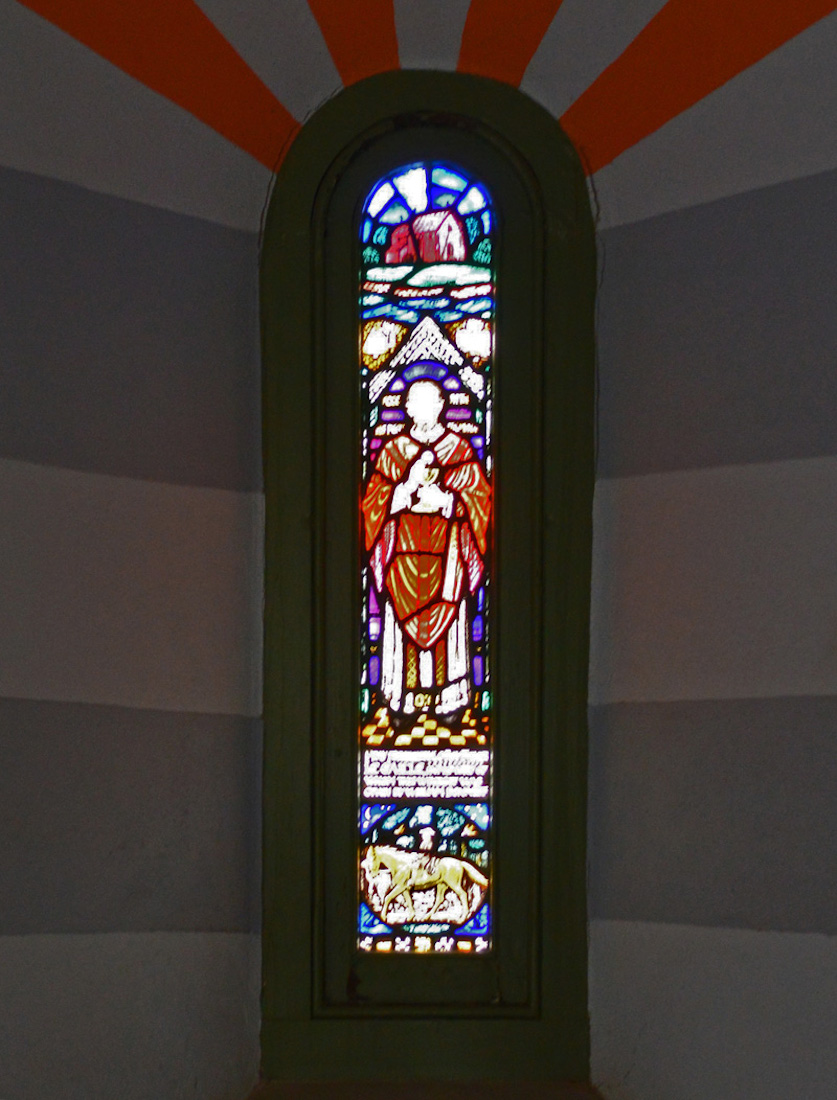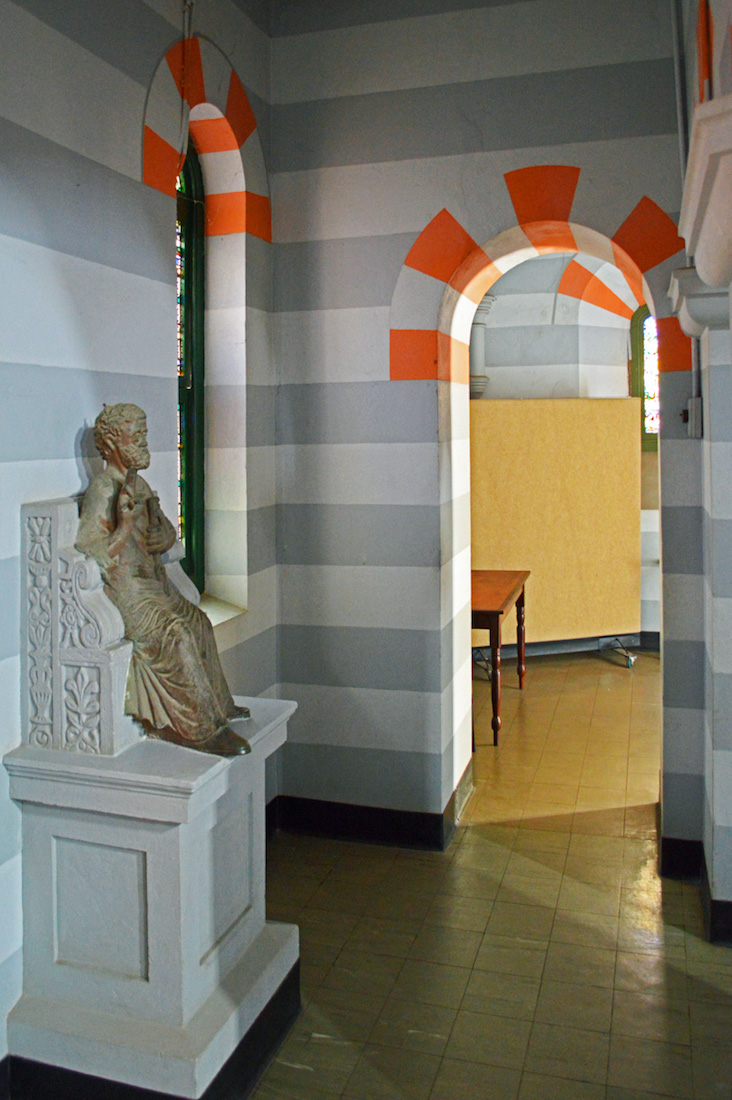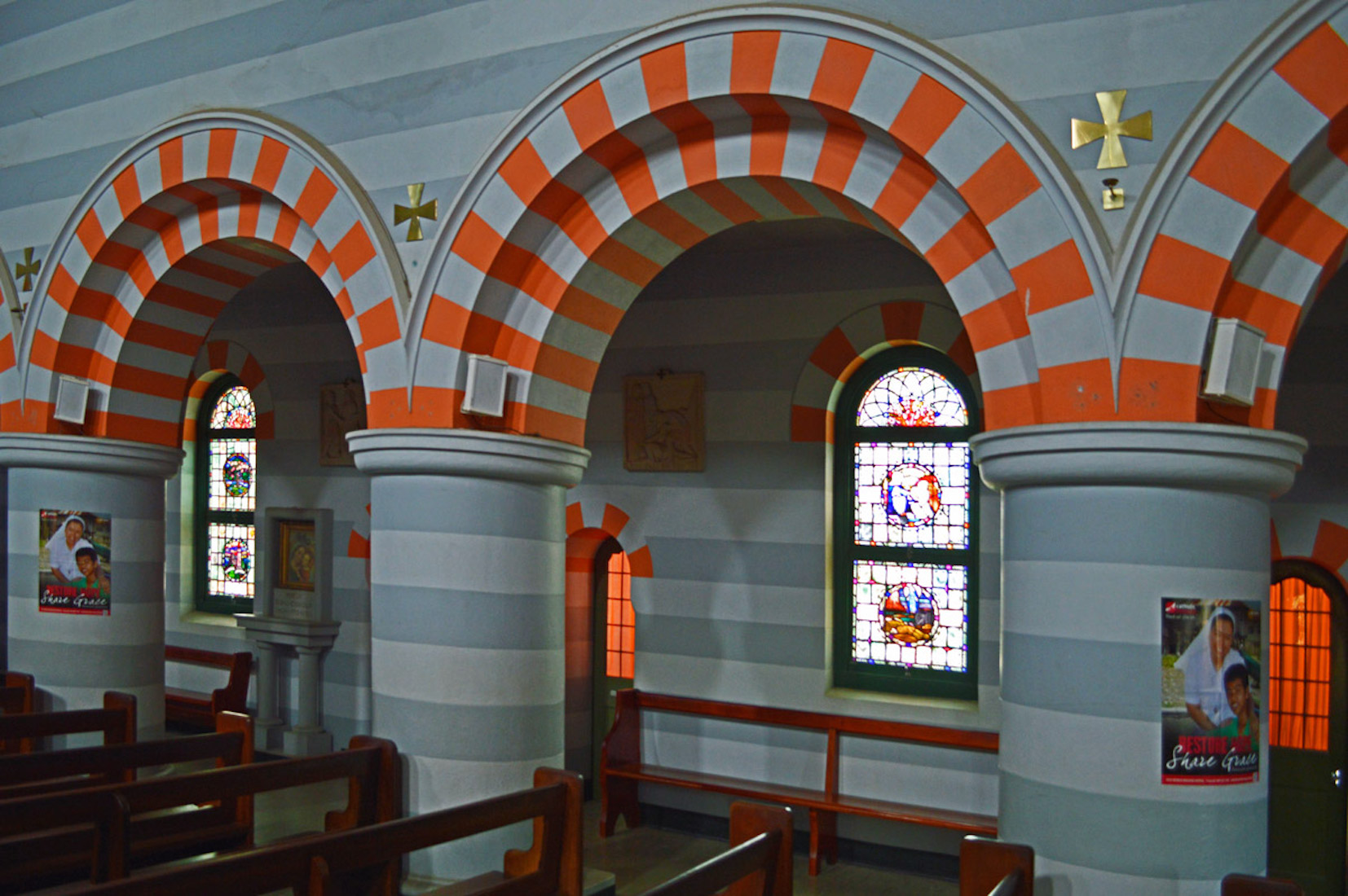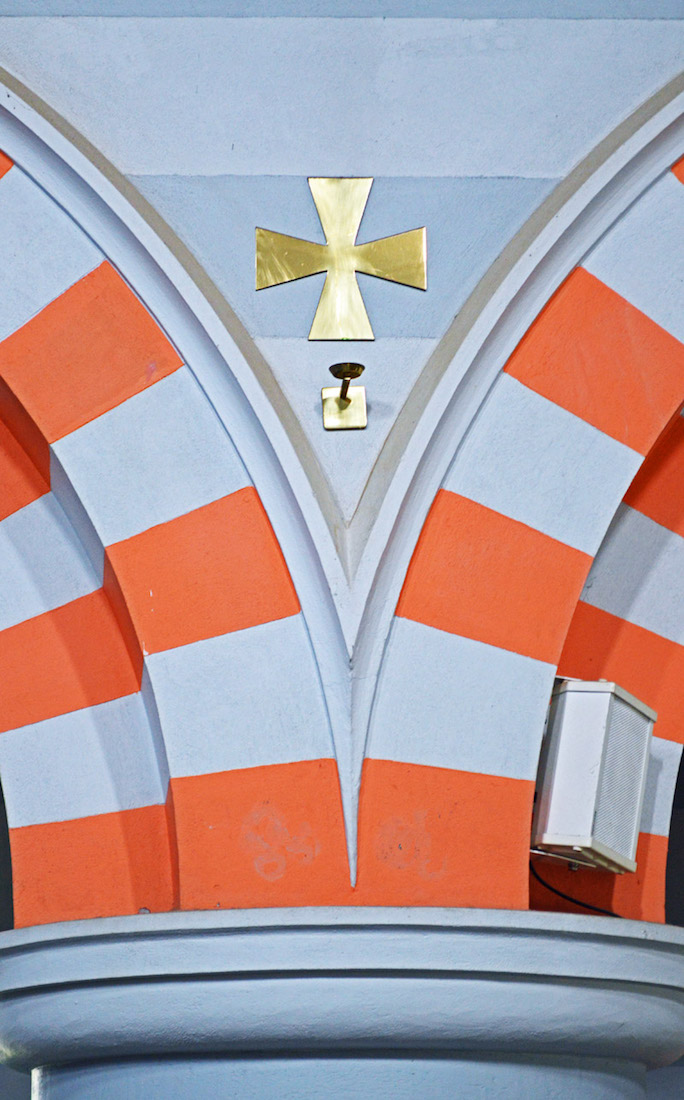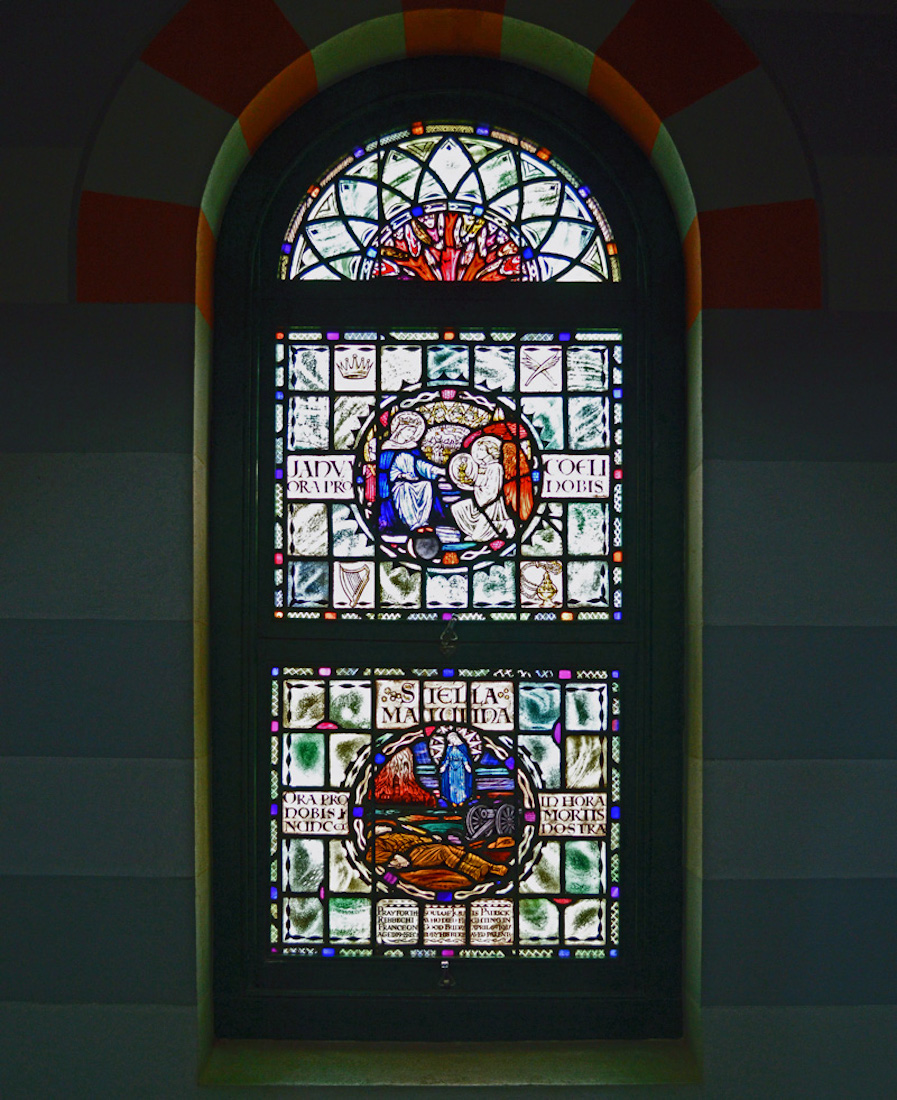
The Brand Highway north from Perth curves west as it enters Geraldton, becoming Cathedral Ave. St Francis Xavier’s Cathedral stands prominently on the left of Cathedral Ave, immediately after it crosses Maitland Street. We notice that the Cathedral is rotated some 50 degrees in a clockwise direction from the liturgical North/South/East/West directions which we use. This may cause some problems for the locals using this site! The Cathedral has a fairly simple plan. There are two towers at the (liturgical) West end, an octagonal dome over the crossing, two short transepts, an Eastern apse flanked by a chapel on either side, and a small tower and Sacristy area in the North East corner. INDEX
2. NORTH WALL
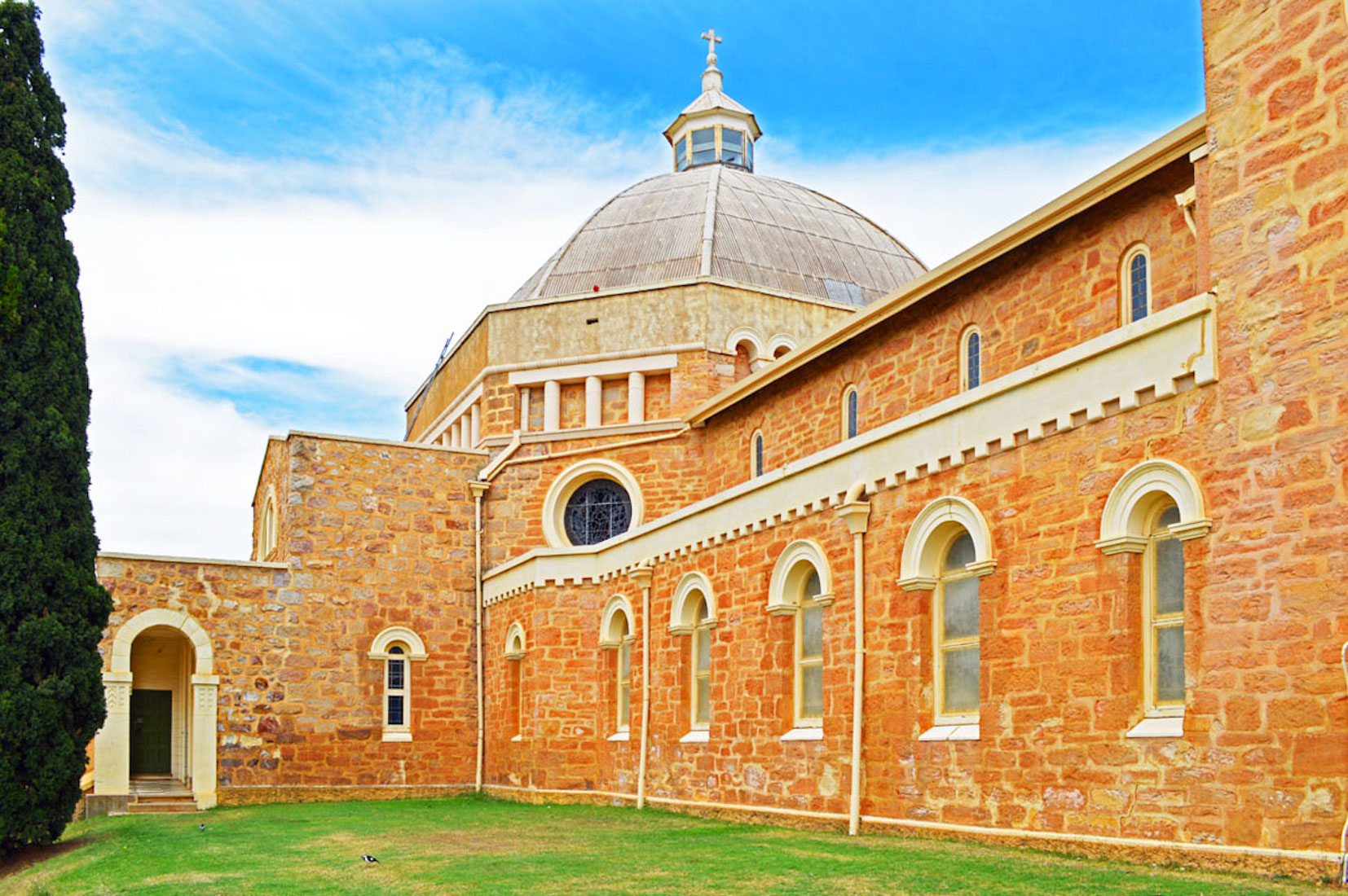
We begin our exploration of this interesting Cathedral approaching from the North West. The work of building the Cathedral began on June 20th, 1916; the building of the Western Nave and Towers was then started. This section of the building was opened in 1918. The cathedral is built of stone from the local Chapman Valley. It is ideally suited to Geraldton’s harsh climate.
3. NORTH EAST VIEW
We move around the Cathedral in a clockwise direction to this North East aspect. In some ways, this newer corner of the Cathedral with its unique round tower is the most tantalizing part, as there is no public access from inside. It is the Sacristy where the Bishop and Priests prepare for services. Architecturally, it is a pleasing addition.
4. SOUTH EAST VIEW
We continue to the South East corner, looking back along the South wall. The octagonal dome with its lantern atop predominates, and we note the short South transept with its green door. At right is the apse, and we also observe a small chapel on the near side – in fact the Lady Chapel.
5. SOUTH DOOR
Steps from the South transept doors lead down to the car park. Notice the little decoration at the top of each column, and also across the lintel of the doors.
6. SOUTH WALL
Continuing to the South West corner, we look back along the South Wall. In the foreground and protruding into the garden area, are two confessionals. We see that this Cathedral is not ‘pretty’ in the traditional sense of English Cathedrals. Priest and Architect John Cyril Hawes thought of his design as a ‘poem in stone’, a building with ‘dignity and repose’. Other phrases used were ‘austere simplicity’ and ‘solidity and massiveness’. It appears that he succeeded!
7. WEST TOWERS
Our tour around the exterior of the Cathedral brings us to the West wall and towers. We notice the bell in the South tower. The North tower has openings for clock faces; these have not eventuated. Time stands still in the outback! Notice the foundation plaques at bottom left.
8. WEST DOOR
Now it is time for us to enter the cathedral. What treats await us inside? But let us first examine the West wall with its ‘French Romanesque’ doorway. The doors lie to the rear of a set of nested semi-circular arches supported by columns of square cross-section. Above, and from between the towers, a saintly figure looks out..
9. WEST WALL DETAIL
St Francis Xavier is depicted holding a cross and a large book (a Bible?). Francis Xavier, 1506 – 1552, was a pioneering Roman Catholic missionary born in Navarre (now part of Spain) and co-founder of the Society of Jesus. He was a student of Ignatius of Loyola and one of the first seven Jesuits, dedicated at Montmartre in 1534. He led an extensive mission into Asia, mainly in the Portuguese Empire of the time. He was influential in the spreading and upkeep of Catholicism most notably in India, but also in Japan, Borneo, the Moluccas, and other areas which had not then been visited by Christian missionaries.
10. DOOR DETAIL
As we enter the West door to the Cathedral, we notice an ornately decorated band around the base of the arch. There are various shields and other decorations of unexplained significance.
11. ST ANTHONY
Just inside the door we meet up with Saint Anthony. He seems to be a frequent visitor to Catholic cathedrals! He is often pictured carrying lilies: these are prolific at the time of his feast day (June 13). Anthony of Padua, also known as Anthony of Lisbon, lived from 1195 to 1231. He was a Portuguese Catholic priest and friar of the Franciscan Order. Though he died in Padua, he was born and raised in a wealthy family in Lisbon. Noted by his contemporaries for his forceful preaching and expert knowledge of scripture, he was the fastest canonized saint and proclaimed a Doctor of the Church in 1946.
12. NARTHEX WINDOW
As we pass through the narthex (or entry porch), we see this window on our right. The window is recessed into a niche with a striped orange and light grey arch above. At the very top is a building which may be a church. Below is depicted a priest carrying the Host, and at the bottom is a horse and rider. The window may thus indicate the ministry of the Cathedral to outlying regions of the State.
13. NAVE
And now our first view down the nave – unexpected, and quite breath-taking. Horizontally zebra striped walls in shades of blue-grey, solid round columns on the sides, and windows and arches with bright orange stripes! The interior resembles the fashion of many churches and cathedrals of Italy, such as Sienna and Orvieto. Visitors who have visited the Great Mosque at El Cordoba, Spain also remark on the similarity of interior design, albeit on a much smaller scale, and the colour scheme.
14. NAVE ROOF
I am always interested in the roof lines of Cathedrals I visit, but there are no surprises here: a simple, strong and practical support system for the gable roof. The fans are essential for a climate like Geraldton’s. Notice the interesting column structure at the far end above the big arch.
15. SOUTH WEST AISLE
We now continue our exploration of the Cathedral by leaving the narthex, and walking along the South aisle. So we come through this arched doorway to find this rather worn saintly figure awaiting us. Curiously, he is wearing a highly polished shoe! Who is he?
16. ST PETER
This Saint in the South aisle is holding a pair of keys, which immediately identifies him as St Peter. In fact there is a great resemblance to the famous statue of St Peter by Amolfo di Cambrio (ca 1300) in St Peter’s Basilica in Rome. On that ancient bronze statue, St. Peter has his right toes worn down by centuries of pilgrims who traditionally touch the foot. Perhaps this statue had some protective footwear initially incorporated as a protective measure, or perhaps it was added later!
17. SOUTH WINDOW
Just to the right of St Peter is a narrower window with a top panel of the Virgin and Child, and a lower panel of St Michael. The window was given in memory of Michael and Mary Morrisey.
18. SOUTH VIEW
This view is taken from the nave across to the South wall from outside the Western-most confessional. For future reference, we notice the flat gold crosses, the window between the two confessionals, the stations of the Cross along the aisle wall, and the Mater Icon with its stand at the left.
19. CROSS DETAIL
A number of churches have twelve gold crosses of this type (a variant Cross Pattée) displayed – one for each of the Twelve Apostles. I assume that this is the case for this Cathedral – but I forgot to count!
20. SOUTH WINDOW (2)
This window is situated on the South wall between the two confessionals. The top inscription reads: Janua Coeli : Ora Pro Nobis, which translates to ‘Heaven’s Gates : Pray for Us’. The picture is of the Angel Gabriel appearing to Mary. The bottom panel shows a dead soldier, with inscription: Ora Pro Nobis Nunc in Hora Mortis Nostra, which translates to : 'Pray for us Now in the Hour of Our Death'. An inscription reads: ‘Pray for the soul of Patrick Rebbechi who died fighting in France on Good Friday April 6th 1917 Aged 19 Erected by his bereaved parents.’


